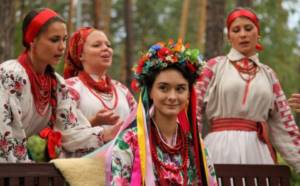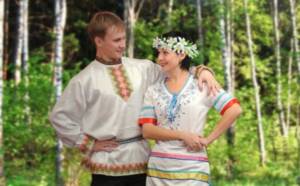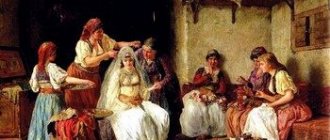People always strive to create a family. After all, being with those who love and appreciate you “as you are” is very pleasant and comfortable. But does everyone think that the birth of a family is, in fact, not only a holiday, but a whole ritual. Huge, multi-stage and very important. During its implementation, a new kind of energy base is laid. The more fun you have, the more strength your family will gain. And first comes matchmaking, the customs of which are very diverse and interesting. Let's take them apart piece by piece. We must start with the fact that our ancestors greatly respected matchmaking. The customs of its implementation varied depending on the territory in which people lived and their beliefs.
Everyone brought something of their own, special, original into them. Nowadays everything can be used. The point is not to exactly copy, for example, the Russian custom of matchmaking. The point is to organize an interesting event that will emotionally involve and unite the participants. This is how the goal is achieved: to fill the nascent family with energy. In some villages they prepared a table and received special guests - matchmakers. In others, they arranged tests for the groom. In the third, they limited themselves to the blessing of their parents. In a broad sense, rituals gave young people a guarantee that the older generation would support them and help them in times of need. In principle, now the internal meaning of the ritual has not changed. It is known that it is difficult for young people to get on their own feet. If not material, then moral “support” they will definitely need. The use of traditional rituals also has another side: chaste. Read more about her.
Matchmaking: customs filled with sacred meaning
If you want to organize the entire wedding ceremony beautifully and interestingly, then it is recommended to be guided by the worldview of the founders of the customs. According to them, matchmaking was a chaste and respectful ritual.
This is a demonstration of the groom’s willingness to submit to the head of the bride’s clan. Although the girl went to his family, the connections remained. The young man needed to “prove” to the bride’s parents that he was a respectable and serious person. In addition, Russian matchmaking customs included elements of healthy humor. For example, in some southern villages the groom was supposed to come to the bride's father with a whip. He offered to beat himself up, but give up his daughter. It must be said that most marriages were concluded based on mercantile considerations. The parents tried to find a better place for their daughter. An unsuitable groom was rejected. This was done in a respectful manner. It was customary to thank the matchmakers for the honor and explain the refusal, for example, by the girl’s youth.
The process of matchmaking a bride in Islam
The Muslim tradition of matchmaking is not very different from the Russian one. As in the case of Slavic custom, matchmakers are sent to the house of the prospective bride, often the groom’s father himself. The matchmaker asks for permission to marry and negotiates with the bride's parents, the girl does not participate in the conversation. She is supposed to wear closed clothing so that only her face and hands are visible.

Matchmaking in Islam
Nowadays the groom himself is allowed to woo the bride, but in any case he will have to discuss everything with the girl’s parents, and not ask her. The matchmaking ritual necessarily includes a bride price - an offering to the bride's relatives, a kind of ransom. These are usually expensive gifts that show the groom's income level. Previously, a calf or other livestock could be presented as a bride price.
But how the matchmaking goes, you can see in the video of the bride’s matchmaking from the groom’s side:
What did a young man do when he wanted to get married?
Entire rituals were invented and sacredly observed everywhere. The first thing the young man had to do was obtain the consent of his relatives for the marriage. Only after this the matchmaking itself took place. Customs ordered him to come to the head of the clan and tell about his chosen one. Usually it was reported who she was, where she lived, and what her relatives were. Most often, the young man was interested in the appearance and attractiveness of the young woman. And the relatives conducted a whole “investigation”, finding out whether the girl was worthy of such an honor. When a consensus was found, matchmakers were chosen. It was a very responsible role. And even now nothing has changed. The fellow rarely went to offer himself as a groom (although this happened). More often this was done by his relatives. One has a godfather or mother, the other has an older brother, and so on.

The young man was also present at the ceremony, but tried not to enter into conversations so as not to spoil the matchmaking.
Customs from the groom's side
The man's trusted representatives were required to demonstrate by appearance and reinforce with words his reliability and dignity. This was done (and is still customary today) very simply. It is necessary to dress beautifully, even richly, if you are going to matchmaking. Customs on the part of the groom include gifts to the bride's relatives. Nowadays people limit themselves to bouquets and sweets. In principle, this is much better than presenting expensive, unnecessary things. So, when you go to “get” the bride, be sure to buy two bouquets. One is for the mother, the second is for the girl. They don't have to be the same. It is customary to give white flowers to young women. And her parent is of a different color. For example, burgundy will show respect. A bouquet made up of different flowers will show that you appreciate the versatility of her personality. Just don't mix it up or overdo it. The girl should remain the center of attention. You’re not going to an anniversary, but to a bride’s matchmaking ceremony. Customs dictate that you should not engage in conversation when walking towards her house. This is considered a bad omen.
Where to hold matchmaking?
Matchmaking does not have to be held at home, now people don’t really like home gatherings, some cozy cafes or restaurants will do, so the groom should ask the bride what her parents think about this and discuss the choice of place in advance.

After the presentation of gifts, everyone moves on to the feast. Many people traditionally bake a loaf of bread for matchmaking on the part of the groom, which is used to greet the matchmakers and which becomes a table decoration. During the feast, the wedding itself, its date, choice of location, and other important details are discussed.
In order to add a touch of variety and fun to matchmaking, it is recommended to hold several competitions and small tasks.
What matchmakers should not do
Many people are currently not interested in folk traditions and take the process of creating a new family lightly. Nevertheless, it has been noted that the behavior of the groom’s representatives affects the future of the family. It is advisable to observe a minimum set of prohibitions when the bride is being matched. Customs suggest that it is necessary to give up alcohol. A matchmaker, dashingly raising glasses of vodka one after another, could bring grief to future children. It was believed that they might become addicted to alcohol. If the matchmaker sat down as soon as she entered the room, then the children did not get up on their feet for a long time and began to walk late. The entire ceremony (before the conspiracy) had to be performed on one's feet.
What to say, how to behave to matchmakers
There are no special rules here. Many people are interested in matchmaking according to Russian customs. They are even trying to write a script. In fact, the whole ceremony goes quickly and unpretentiously. The matchmakers (groom) come and present bouquets to the bride and her mother. The girl is then removed from the premises. And the conversation begins. The matchmakers speak first. They say that there is a good fellow, handsome, dexterous and skillful (and so on according to the list). And you have a turtle dove waiting for its dove. So why can’t we work things out, unite two young souls? What follows is the response from the girl’s relatives. This is approximately how matchmaking works according to Russian customs. No script required. Only if you yourself want to turn the meeting into a fireworks display of pleasure. Then you can come up with competitions and quizzes. After the main words are said, everyone sits down to drink tea.
How to behave for bride's relatives

The girl’s parents, if they liked the groom, were obliged to close the door with a hook. This was done so that a random visitor would not jinx the whole thing. That is, translated into modern language, we can say that a certain secret surrounded the matchmaking on the part of the bride. Customs suggested that her relatives “shut off” from the rest of the world for this short time. This is what you should do. Do not invite other guests. The conspiracy must be carried out in an intimate setting, only among trusted persons. If someone accidentally runs into the light, boldly and mercilessly send them away. The new family has no need for foreign energy. It was also recommended to touch the table leg to protect against the evil eye. This is done so that “happiness does not run away.”
The role of the bride and groom in the matchmaking ritual
Previously, in Russia, a young man often first decided to start a family, and only after that chose the lucky one. It was not uncommon for a potential bride to be unprepared for the happiness that befell her until the day of matchmaking.
In the matchmaking ritual on the part of the bride, the girl’s role was passive - she could sit in her room all evening without showing herself to the groom. The matchmakers negotiated with the parents, looked at and assessed the bride's dowry. A girl could only be called to demonstrate her skills in housekeeping, cleaning, and cooking. The bride had to submit meekly, silently show her skills and again retire to the waiting room.
If the bride was good at weaving, sewing or embroidering, then she wore clothes of her own making that emphasized the dignity of her figure, but was not provocative.
In the dowry chest, the groom must have seen tablecloths, towels, and napkins made by the skillful hands of his chosen one for arranging their future life together. On the evening of the matchmaking, the girl could also be asked to demonstrate how she sews, embroiders, sweeps floors or cooks, in order to make sure that she really knows how to do all this and that her parents do not embellish her merits. At the same time, the parents were obliged to praise their daughter, admire the work done and, looking ahead, describe to the groom how good it would be for him to live with such a thrifty wife. The groom, based on the girl’s external data and her abilities, concluded whether she was suitable for him as a wife or not. The latter happened rarely, but if the girl’s family was unable to adequately present the goods during the matchmaking, then the groom could well back down, for this there was a special system of signs - he turned away from the food and drink offered, could demonstrate in every possible way that he was being treated tastelessly and did not finish the offered drinks.
With a successful combination of circumstances and mutual sympathy of all matchmaking participants, at the end of the event, the bride’s parents gave their consent to the wedding, and from now on the guy and girl became the bride and groom. Nowadays, matchmaking is not a very common phenomenon. Parents are presented with a fait accompli, and then all future relatives are shown one by one to each other in different combinations. The most common matchmaking scenario on the part of the bride is when first the groom comes to visit the bride’s parents, then the bride goes to visit the groom’s parents, and only then the parents get to know each other and begin to discuss organizational wedding issues. If you want to add an element of tradition to the dating procedure, the main thing is not to overdo it.
Also read about matchmaking on the part of the groom. Read our article for tips on organizing this event. Are you getting ready for your wedding? Then only here you will find a huge number of wedding hairstyles.
How to respond to an offer
It is advisable for the bride's parents to adapt to the style of the matchmakers. This will make the holiday more fun, and communication will be more comfortable. If you start praising your fiancé, then don’t lag behind and praise the girl to the skies. Keep in mind that you may be asked tricky questions about a girl if you come across someone who has truly studied matchmaking. The customs (scenario) in some areas involve praising your own “product” and blaspheming “strangers”. For example, they will ask whether the bride has a sideways view or is weak with her little legs? There are matchmakers who get personal, trying to confuse parents. You should laugh it off and give an answer quickly. And it can be straight or half. If you like the groom, then the girl is called and the father joins their hands. Sometimes parents need time for “family council.” That's what they say directly. This is where the “official part” ends.

What then?
The information described refers only to the first stage. It turns out that the matter does not end there. After all, the point of the ritual is to bring relatives closer. This is what matchmaking is based on. Traditions and customs require a second meeting in the same composition. The bride's side is already inviting her. A feast with all sorts of delicacies is prepared, and the date of the visit is determined. Parents of the young and close family members gather together. The bride is also present at this meeting. Various nuances of arranging the life of the new “unit of society” are discussed there. For example, where should they live, who will provide what, and so on. The party itself is held with the goal of bringing future grandparents together, who will now have many common joys and problems. Here you can already drink a glass to “open your soul.” It is not forbidden to show off your talents. In general, future relatives behave more naturally than during matchmaking.
A few more signs
Urban people usually don’t delve into all sorts of jokes that everyone in the village knows. However, it must be remembered that the bride who decided to refuse the agreement (after matchmaking) has her gates smeared with tar. And today you can receive such an unpleasant “gift”. They will come and stain the front door with an unpleasant-smelling substance. Do not be surprised. The groom's refusal of the girl was considered a terrible insult. No one matched this one for a long time. Families became terrible enemies. Nowadays, of course, everything is simpler. Young people should keep in mind that a change of decision will have to be explained not only to their loved one, but also to his family. After the conspiracy, many people will be involved in your personal issues and their relationships will begin to develop. You should understand this and not “jump in the face” when you accidentally quarrel. Matchmaking did not take place on Fridays (and Wednesdays). These were traditionally fast days. Going for a bride at this time was considered a bad omen.

Wedding ceremony of the Don Cossacks in time and space
Rituals and traditions of the Cossacks— 3 —
The pre-wedding once consisted of the following episodes:
• matchmaking, consisting of choosing a matchmaker and matchmakers (there was no institute for professional matchmakers on the Don, and therefore the most efficient and quick-witted Cossack women from among the groom’s relatives ended up as matchmakers); the arrival of matchmakers at the groom’s house and the beginning of matchmaking (the latter is characterized by numerous options for allegorical explanations of the reasons for the appearance of guests (“the heifer got lost,” “the marten hid,” “the gobblers flew in,” etc.); the viewing of the bride with elements of a practical joke, replacing the girl with an old woman, etc.; advice from matchmakers and groom's relatives about the merits of the bride and groom and their mutual agreement; drinking (Don. vody, vody, agreements), during which they joined the hands of the future couple, covering them with a scarf (see above), and reached mutual agreement to continue the ritual, conspiracy, or hand-shaking, i.e. engagement, with a mandatory charge - a kind of insurance in case of refusal of one of the parties and a sing-along (Don. binge, feast), at which the young people were officially declared the bride and groom and the costs of the parties, the volume of masonry, subsequent actions, etc. were discussed; the end of the matchmaking, the positive result of which the villagers or farmers were notified with the help of several songs sung by the participants in the conspiracy, going home;
• looking at the place (don’t look at the stoves, stroke the walls, look at the ashes, etc.) as an official visit by the bride (another sign of her freedom in the ritual) and her relatives to the groom’s house, the future habitat, with the obligatory element of communication with the household penat-brownie in the form of various manipulations with the Russian stove (raking out ash, whitewashing scratched walls);
• communication between the bride and groom in a non-ritual form, as well as at parties organized by the bride, who is intensively preparing gifts for her betrothed;
• pillows, i.e. bringing the dowry to the groom's house with the obligatory songs, food and erotic games with the bed;
• hen party and bachelor party (don. evening) with a noticeably developed hen party plot (choosing a groomsman, who, as a rule, became the closest, secret friend of the bride, playing with sad songs about parting with the girl’s will, trying on a wedding dress, etc.) and an elementary bachelor party feast.
An indispensable component of the pre-wedding were ritual songs , the “start” for which was a conspiracy. On the Don, a stable repertoire of pre-wedding songs has developed, reproduced almost throughout the entire territory of the Department of Internal Affairs, including such texts as “On the mountain there is an oak, there is a birch tree,” “Yes, the swan has a swan under its wing,” “In the garden in the earthly nightingale tickles the viburnum,” “ The matchmakers hit the hands, they laid charges” (at matchmaking; as an example of a song based on the ritual, here and below we present data from the village of Nizhne-Kundryuchenskaya), “A drunken drunkard”, “Yes, a white bunny is a young ermine”, “A stranger has visited us now "(at an engagement agreement), "The month has enlightened the path", "Don't whisper, don't gurgle at her", "And we were a matchmaker" (on "pillows"), "Green Dubrova" ("Dubrova, Dubrovushka" - for orphans), “Evening, evening, parties”, “My light, the maiden will” (at a bachelorette party). Let us note, by the way, that practically none of the named songs are represented in the folklore wedding repertoire of the Russian tradition itself[24], which indicates the creative development of the ritual by the Don Cossacks. Pre-wedding in the 20th century. is reduced both in the number of episodes and in the song service. Matchmaking practically comes down to a one-time visit by matchmakers to the groom's house (in the old days it lasted for several receptions-feasts), during which the whole range of issues related to preparation for the wedding was discussed - this concretion is lexically manifested in the semantic diversity of wedding terms: in different villages the same and the same word can be used to describe a variety of matchmaking episodes. A natural consequence of this reduction was a reduction in the number of songs, and in some areas, the almost complete disappearance of the pre-wedding repertoire.
The wedding day in the Don rite is planned as meticulously as the pre-wedding day, and the plot of this day remains unchanged even in the modern performance of the ritual. This day begins with the unveiling of the bride, who plays sad songs at dawn about parting with relatives and the maiden will (an orphan is unveiled at the graves of his parents), and this ritual is presented sporadically on the Don, because in essence it is most often performed the day before, at a bachelorette party.
The following are performed sequentially:
• dressing the bride , with such an archaic element as standing on a fleece (felt) or an inverted fur coat (through which the bride “communicates” with her ancestors, hoping for their blessing), as well as with constant amulets (see above);
• departure of the brave train of the groom for the bride: “There was a wedding on Michaelmas day. On Michaelmas, brides should go out on horseback with friends. Mine had six shchilaveks and was shakhvirou, I was the seventh. They followed her. A ruler or a droshka, a pair of lashes of zyprizhona from these droshkas, two divorces - pyizhzhani, this mustache there - songs, this may radnya wusya - called paizzhany. We mounted and galloped on horses, and on the droshkas - there was a drushka and a matchmaker, a big one, and a kushchir” [25]; the Cossacks galloping to the bride feel like hunters (in the 17th century, hunters were called gulebschiki, and later gulebniki were guests at a wedding), pursuing “a young marten - a beautiful maiden”;
• sitting on the bride's seat in the red corner awaiting the groom's arrival;
• overcoming obstacles by the brave train of the groom - the reward for his “feats” is his appearance near the bride;
• redemption of a place - a comic bargaining with its custodians, who after the sale become an object of ridicule and reproachful accusations (see below);
• treating the bride's guests and saying goodbye to her home and family - episodes full of songs;
• the passage of the brave train to the church with the appearance of the wedding sorcerer in this episode (see below) and the wedding, carried out in strict accordance with the canon;
• meeting of the newlyweds in the groom's house with the active inclusion of spectators in the ritual (Don. lookers, watchers), who receive not only candies, nuts and money during the sprinkling, but also pieces of the counter (butter bread that is broken over the newlyweds' heads);
• wedding feast and gifts (Don. Darezh, cheese loaf), a distinctive feature of which in ancient times, and especially at the weddings of ordinary Cossacks, was the so-called green heifer, i.e. deferred gift: offspring of livestock, poultry, which the newlyweds receive after birth (remember that gifts can be transferred to the second day of the wedding);
• bridal wrap – replacing a girl’s hairstyle (two braids) with a woman’s one. The resulting sack is hidden in a cap or fake, by which one could always identify a Don Cossack woman; taking to bed, in the Don tradition, performed delicately, unnoticed, without attracting the attention of the feasting;
• evening guests – the invitation of the bride’s relatives to a feast at the groom’s house is not universally observed.
[24] See: Russian wedding: In 2 vols. M.: State. rep. Center of Russian Folklore, 2000. [25] Galushkin V.D., born 1909, art. Semikarakorskaya (B.P. Archive).
— 3 —
News from the Russian Museums portal
The feed is provided by the portal Museums of Russia Please send materials and wishes to the address
Engagement
In Rus', young people were considered the bride and groom after an agreement when the girl’s relatives agreed to the marriage. Nowadays it is customary to hold a special holiday to confirm this. They called it in a foreign language - engagement. It differs from conspiracy only by an additional feast. There is nothing bad about it. The closest ones are invited to the holiday. They communicate and find common ground. In addition, the couple's parents get an additional opportunity to discuss the future wedding and other important issues in a more relaxed, informal atmosphere. While young people are having fun, they can have a heart-to-heart talk, set priorities, and introduce each other to fundamental issues and views. It must be said that the more often the older generation communicates, the better the life of the newly-made family will be. There is no need to “settle” inevitable disagreements for the “old people.” They will cope themselves when they begin to feel close to each other.
How does matchmaking work these days?
There are no specific requirements for matchmaking; even in Rus', the customs of matchmaking differed depending on the region.
Theatrical performances are rarely staged. Basically, matchmakers are close relatives of the groom or close friends of the parents, and they can exchange some traditional phrases or poems. What do they give for matchmaking? The groom, according to tradition, gives flowers to all women present (the bride, her mother, sister, aunt, etc.). Some give fruit baskets, sweets, and alcohol.
Sets of cosmetics, accessories, and, less commonly, jewelry are also acceptable. This is exactly the kind of jewelry that the groom often gives to the bride for matchmaking. Many families have a tradition of giving family jewelry, and this event is the most appropriate occasion. The bride also presents small gifts to her future mother-in-law and father-in-law, mainly something useful for the home.
On a note. Such an old ritual as bridesmaids is carried out before matchmaking in our time. But now we just call it getting to know the parents.

According to the old tradition, matchmakers should not talk to anyone on the way; upon entering, they must slam the front door three times. In modern high-rise buildings it is difficult to imagine that someone would do this, but many people like to follow some conventions. Although, if matchmaking takes place in a private house, then it is quite appropriate.











